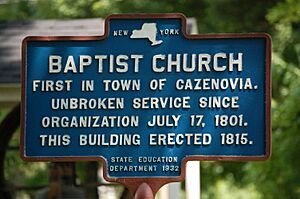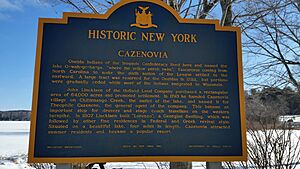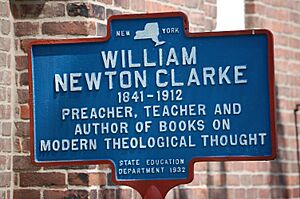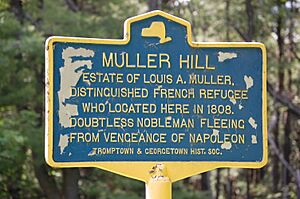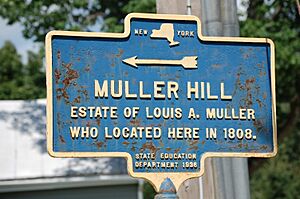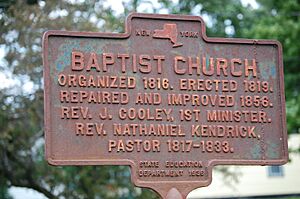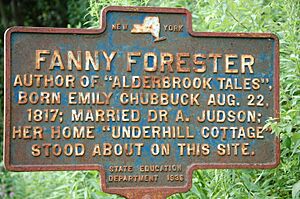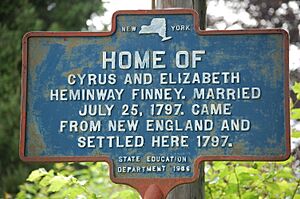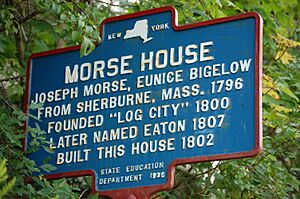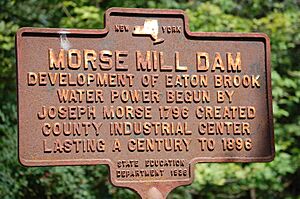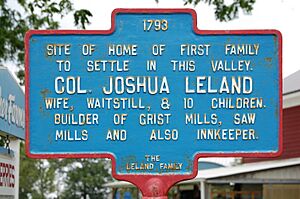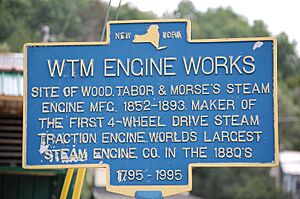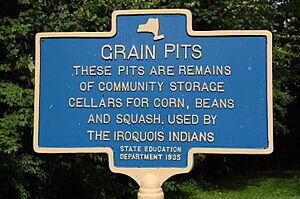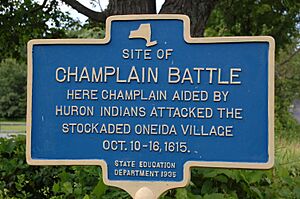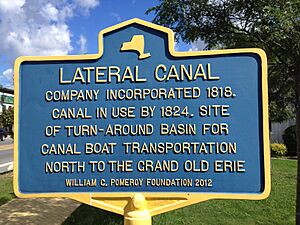List of New York State Historic Markers in Madison County, New York facts for kids
New York State Historic Markers are special signs placed around the state. They tell us about important places, people, and events from the past. These markers help us learn about the history of New York, from early settlers to famous leaders and significant moments. This article explores some of the interesting historic markers you can find in Madison County, New York.
Contents
Historic Markers in Madison County
Cazenovia Area Markers
Cazenovia is a town with a rich history, marked by several important signs.
Baptist Church in Cazenovia
The Baptist Church in New Woodstock, Cazenovia, has a long history. It has been holding services since July 17, 1801. The building you see today was built in 1815. This marker celebrates its continuous service to the community.
Founding of Cazenovia
Another marker simply named CAZENOVIA is located near Cazenovia Lake. It reminds us of the founding of the Village of Cazenovia itself, a key moment in the area's development.
First County Seat
The FIRST COUNTY SEAT marker on Seminary Street tells us about an old building. It was built in 1810 to be the courthouse for Madison County. Courts met there from 1812 to 1817. Later, in 1818, it was sold to Methodists, and in 1824, the Conference Seminary was started there.
William Newton Clarke
A marker for WILLIAM NEWTON CLARKE is also on Seminary Street. He lived from 1841 to 1912 and was a preacher, teacher, and author. He wrote books about modern religious ideas.
Temperance House
The TEMPERANCE HOUSE marker is found east of Oran. This building served as a tavern on a turnpike for almost 60 years. It was built and opened by Cyrenus Bartholomew in 1815. It closed in 1872 when a new railroad opened and bypassed it.
De Ruyter Area Markers
De Ruyter is known for its connection to a very famous New Yorker.
Ezra Cornell's Boyhood Home
A marker for EZRA CORNELL is located about 3½ miles east of De Ruyter. It points to where his boyhood home stood. In 1828, he walked from here to Ithaca, where he later founded Cornell University, a major university. Another marker on NYS 13 in De Ruyter also points to the site of his boyhood home.
Muller Hill Estate
Two markers, both named ARROW, point to the Muller Hill Estate. One is about 5 miles east of De Ruyter, and the other is on NYS 80 at Georgetown. This estate belonged to Louis A. Muller, who settled there in 1808. He was a distinguished French refugee, possibly a nobleman escaping from Napoleon.
Eaton Area Markers
Eaton has many markers, highlighting its early settlers and industrial past.
Baptist Church in Eaton
The BAPTIST CHURCH marker on NYS 26 in Eaton tells us about another early church. It was organized in 1816, and the building was put up in 1819. It was repaired in 1856. Reverend J. Colley was the first minister, and Reverend Nathaniel Kendrick served as pastor from 1817 to 1833.
Dr. James Pratt
DR. JAMES PRATT was the first doctor in the Town of Eaton, arriving in 1797. He also taught the first school in the homes of early settlers like Joseph Morse, Colonel Leland, and Thomas Morris.
Fanny Forester
The FANNY FORESTER marker is about half a mile west of Eaton. Fanny Forester was the pen name of Emily Chubbuck, an author born on August 22, 1817. She married Dr. A. Judson. Her home, "Underhill Cottage," stood near this site. She was known for her "Alderbrook Tales."
Home of Cyrus and Elizabeth Heminway
A marker for the HOME OF Cyrus and Elizabeth Heminway is on NYS 26 in Eaton. They were married on July 25, 1797, and came from New England to settle here in 1797.
Morse House and Mill Dam
The MORSE HOUSE marker on NYS 26 in Eaton tells us about Joseph Morse and Eunice Bigelow. They came from Sherburne, Massachusetts, in 1796 and founded "Log City" in 1800, which was later named Eaton in 1807. Joseph Morse built this house in 1802.
The MORSE MILL DAM marker, also on NYS 26, highlights the importance of water power. Joseph Morse began developing the Eaton Brook water power in 1796. This created an industrial center for the county that lasted for a century, until 1896.
N.Y. State School of Agriculture
Two markers for the N.Y. STATE SCHOOL are on US 20 at Morrisville. This refers to the New York State School of Agriculture at Morrisville, which was established in 1908. Its first director was F.G. Helyar, who served from 1910 to 1917. This school is now SUNY Morrisville.
Sage Tavern in Log City
The SAGE TAVERN IN LOG CITY marker on NYS 26 in Eaton points to a very old house. Built and run by Isaac Sage in 1802, it is the oldest house in the Village of Eaton.
Site of Colonel Joshua Leland's Home
The SITE OF HOME marker, about 2 miles northeast of Eaton, marks the home of Colonel Joshua Leland. In 1793, he was the first settler in this valley. He also built the first grist mill (a mill for grinding grain) on the stream between the ponds.
WTM Engine Works
The WTM ENGINE WORKS marker is behind the A-n-W Gas Station in Eaton. This was the site of Wood, Tabor & Morse's steam engine manufacturing company from 1852 to 1893. They made the first 4-wheel drive steam traction engine and were the world's largest steam engine company in the 1880s.
Toll Gate No. 2
The TOLL GATE NO. 2 marker on NYS 26, west of Eaton, marks a spot on the Peck's Port, Eaton, and Georgetown Plank Road, built in 1849. Toll gates were places where people paid a fee to use the road.
Fenner Area Markers
Fenner is home to markers related to early Native American history.
Grain Pits
The GRAIN PITS marker at Nichols Pond, south of Canastota, shows the remains of community storage cellars. These pits were used by the Iroquois Indians to store corn, beans, and squash.
Site of Champlain Battle
The SITE OF CHAMPLAIN BATTLE marker, also at Nichols Pond, tells about a significant event. Here, Samuel de Champlain, aided by Huron Indians, attacked a fortified Oneida village from October 10-16, 1615. This was an important battle in early colonial history.
Lebanon Area Markers
Lebanon has markers about early settlers and important historical figures.
First Settlers of Madison County
The marker HERE IN 1788 STOOD on a county road south of Eaton points to the bark hut of Bates, Stowell, and Salisbury. They were the first settlers of what is now Madison County.
Horace Stowell's Home
The HOUSE BUILT BY marker, also south of Eaton, refers to a home built by Enoch Stowell Jr., an early settler. This house later became the home of Horace Stowell, a prominent abolitionist (someone who worked to end slavery). It was a station on the Underground Railroad, a secret network that helped enslaved people escape to freedom.
Smith's Valley
The SMITH'S VALLEY marker at Randallsville tells about Colonel W.S. Smith and his family. They were early settlers and owned large areas of land in this region.
Lenox Area Markers
Lenox has markers related to local politicians and military history.
Home of Milton Delano
The HOME OF marker on NYS 13 in Canastota tells about Milton Delano. He was the Clerk of the Town of Old Lenox, twice elected Sheriff of Madison County, and served as a Member of Congress from 1888 to 1892.
Quality Hill Green
The QUALITY HILL marker on NYS 5, west of Canastota, notes a place where a company of horse artillery drilled during the War of 1812.
Sullivan Area Markers
Sullivan has a marker for an important canal.
Lateral Canal
The LATERAL CANAL marker in Chittenango, on Parker Lane, highlights a significant waterway. The canal company was started in 1818, and the canal was in use by 1824. This was the site of a turn-around basin for canal boats traveling north to the larger Erie Canal.
See also


